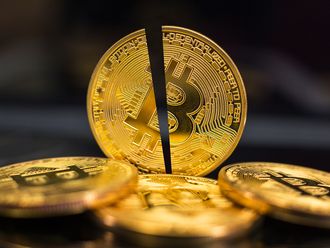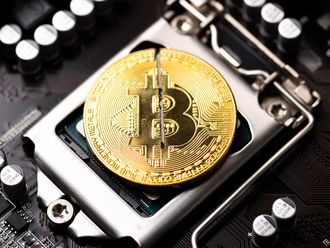Washington: Make way, bitcoin: A competing digital currency is angling for the spotlight.
Merchants and investors are taking notice of litecoin, pitched by its developers as cheaper to generate, more plentiful and easier to use for small transactions than bitcoin. While prices for both have slid since a surge late last year, litecoin’s remains about 490 per cent higher than six months ago, compared with about 140 per cent for bitcoin. Daily litecoin transactions also have climbed faster.
The total value of litecoins available for use ranks second only to bitcoin’s, according to CoinMarketCap, a website tracking more than 200 digital currencies. That status has helped make litecoin an obvious alternative for investors and enthusiasts seeking new opportunities to profit from virtual money.
“Litecoin right now is where bitcoin was the same time last year,” Michael Curry, co-founder of Canadian digital-currency exchange Vault of Satoshi, said in an interview. “As people are becoming more familiar with bitcoin, they are starting to see there are other coins out there.”
Bitcoins jumped from about $13 (Dh48) at the start of last year to more than $1,200 in December, then slid to about $490 as of Thursday, according to CoinDesk, which tracks prices across key exchanges. Litecoins, which surpassed $48 in November, traded for about $12 Thursday, according to data from exchange BTC-e.
The average number of daily transactions in litecoins this month is 155 per cent greater than October’s level, according to CoinDesk data. That compares with a 19 per cent increase for bitcoins. Daily transactions in bitcoins this month still outnumber those in litecoins almost sevenfold, the data show.
Cheap alternatives
Technology enthusiasts and venture capitalists are pitching digital currencies as fast and cheap alternatives to traditional financial systems, in which middlemen such as networks, merchant acquirers and banks take a cut. Backers also argue that instruments such as bitcoin may be of use to people and businesses in countries with unstable currencies.
Litecoins are drawing notice in part because they can be mined more cheaply than bitcoins. The process uses computers to solve software problems and unlock new digital coins. While bitcoin speculators compete with increasingly expensive machines, litecoins were designed to be efficiently mined with consumer-grade hardware, even if some miners prefer powerful processors.
Sam Cole, co-founder of KnCMiner, one of the biggest mining companies, said equipment used for mining litecoins and similarly designed alternative currencies now accounts for 60 per cent of sales.
The maximum number of litecoins that can be mined is four times more than that for bitcoins, potentially making them more attractive to users and miners. Miners have more rewards to go around, while consumers may see litecoins as more affordable, even if bitcoins are typically spent in pieces.
“This will make litecoin appear more accessible, since its price will climb more slowly than bitcoin,” said Nicholas Colas, chief market strategist at ConvergEx Group, a trading services company in New York.
While both digital currencies can be used at online stores for services and products, such as cosmetics and video games, bitcoin is accepted more widely. Still, some merchants are paying attention to litecoins. Patrick Byrne, chief executive officer of Overstock.com Inc, said in an interview that the online retailer is considering accepting litecoins.
More prominent
“It’s time I start looking hard at it,” said Byrne, whose Salt Lake City-based company accepts bitcoins. “We certainly want to be always at the forefront of accepting such currencies.”
More than 36,600 computers are part of the litecoin network, according to BitInfoCharts. That’s more than half of the 63,000 nodes for bitcoin, which is more prominent and two years older. At Vault of Satoshi, litecoins account for 20 per cent to 25 per cent of all trades, Curry said.
At Verbena Products, which sells beauty supplies, litecoin accounts for more than 20 per cent of all alternative-currencies sales, while bitcoin takes up the rest, President Robert Roque said in an interview.
“In terms of a payment solution for us, it’s as good as bitcoin,” Roque said. “It just doesn’t have the popularity of bitcoin. But a lot of exchanges are beginning to accept litecoin, and that should create liquidity for the future.”
Litecoin was created in 2011 by Charles Lee, who now works for bitcoin company Coinbase. Based on the bitcoin software, it seeks to offer improvements on the basic technology, including a faster transaction time to ease purchases of small items, like coffee or bagels.
Volatility
“Litecoin has always been viewed as silver to bitcoin’s gold,” Anton Yemelyanov, one of the core litecoin developers, said in an interview. “Bitcoin would be used to transact larger value transactions, whereas litecoin would absorb smaller transactional value.”
Some alternative-currency enthusiasts advocate investing in both bitcoins and litecoins to hedge risks.
“If something like a bitcoin failure does take place, litecoin is next in line and uses a different algorithm, so likely won’t fall with bitcoin,” said Colin Lusk, a networking engineer in Portland, Oregon, who mines and owns both currencies.
Many digital-currency prices have dropped this year as authorities in a growing number of nations resist virtual money, warning that the instruments suffer from volatility, can be exploited for money-laundering, fraud and terror financing, and may be vulnerable to robbery via hacking.
Litecoin’s longevity isn’t assured. Some 230 alternative coins exist, according to CoinMarketCap, with more added weekly — and nearly each one touts unique features. Several of them, such as dogecoin, are gaining attention. For now, most venture capitalists are still focused on bitcoins.
“Alternative currencies are great,” said Adam Draper, CEO of Boost VC, which invests in bitcoin startups. “They all run into the same problem, though, which is: They are not bitcoin.”








_resources1_16a30b358e0_small.jpg)

